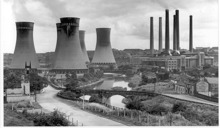44th Anti-Aircraft Brigade (United Kingdom)
44th Anti-Aircraft Brigade (44 AA Bde) was an air defence formation of Britain's Territorial Army (TA).
[1][2][3][4][5][6][7] At the time the brigade was formed, the TA's AA units were in a state of mobilisation because of the Munich crisis, although they were soon stood down.
AA Command mobilised fully on 24 August, ahead of the official declaration of war on 3 September.
81st AA Regiment manned two HAA battery sites and also deployed Lewis guns as LAA cover for the Vital Point (VP) of the Metropolitan-Vickers factory at Trafford Park.
In addition, the women of the Auxiliary Territorial Service (ATS) companies were taking over their duties with the regiments.
[9] On 1 November the brigade was reorganised, with 39th and 71st S/L Rgts transferring to the command of 53rd Light AA Bde covering the Mersey area, followed shortly afterwards by 62nd S/L Rgt.
[24] Most of the air raids in 4 AA Division's area during the Battle of Britain were in the West Midlands or over the Mersey.
[5][6][7][9] He was succeeded in command of 44 AA Bde by Lt-Col Erroll Tremlett, a former first-class cricketer who had distinguished himself commanding 54th (Argyll and Sutherland Highlanders) LAA Rgt at the Dunkirk evacuation, where his guns had defended the Mole and protected the embarkation of many of the troops.
[33][34] The Royal Artillery's historian considered that during these attacks on British cities 'the actions fought [by the AA batteries] were as violent, dangerous and prolonged as any in the field'.
One Gunner loaded 127 of the [86 pounds (39 kg)] rounds himself in eleven hours of action, despite injuries to his fingers'.
By now the HAA sites had the advantage of GL Mk I* radar with an elevation finding (E/F or 'Effie') attachment to supplement searchlights.
Additional LAA guns (mainly Bofors, with a few Oerlikon 20 mm cannon) were sited singly at Yarmouth, Shanklin, Sandown and Ventnor.
[74][76][79][81] Brigadier Vere Krohn, MC, TD, a former head of AA Command's technical branch, arrived from 43 AA Bde to take command on 2 May, and began redeploying the HAA sites and additional radar-controlled searchlights to tackle aircraft attempting to lay mines in the Solent.
As 21st Army Group overran the main launch sites in the Pas-de-Calais, the Luftwaffe shifted its focus to air-launching V-1s over the North Sea during the autumn, and AA Command redeployed units from the South Coast to Eastern England in response.
[27][76][83] 44 AA Brigade 'blacked out' its searchlights on 12 November apart from those required as homing beacons for friendly aircraft, and the crews were sent to provide construction parties for the gun sites in the new 'Diver Strip'.







